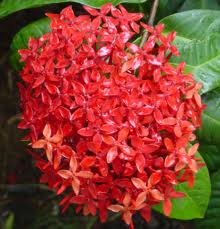| PlantID | 0086 |
| Botanical Name | Ixora coccinea |
| Common Name | Bandhuka |
| Classification | | Kingdom: | Plantae | | Subkingdom: | Tracheobionta | | Division: | Magnoliophyta | | Class: | Magnoliopsida | | Subclass: | Asteridae | | Order: | Gentianales | | Family: | Rubiaceae | | Genus: | Ixora | | Species: | coccinea |
|
| Part used | Roots, leaves and flowers. |
| Medicinal Properties | Roots: astringent, acrid, febrifuge, sedative, stomachic and antiseptic. Flowers: astringent, bitter, sweet, carminative, digestive and constipating.
|
| Medicinal Use | Roots: useful in hiccough, fever, gonorrhoea, anorexia, diarrhoea, dysentery, cephalagia, sores, chronic ulcers and skin diseases. Leaves: useful in diarrhoea. Flowers: useful in dysentery, dysmenorrhoea, leucorrhoea, haemoptysis, catarrhal bronchitis, ophthalmopathy, sores and ulcers.
|
| Chemistry | Root: acrid aromatic oil, tannin, fatty acids and a white crystalline substance. Root-bark: II-octadecadienoic acid, mannitol and myristic acid. Flowers: yellow coloured quercitrin, wax and neutral crystalline substance.
|
| Cultivation | NA |
| Regional Habitat | Generally founds in forest lands and road cutting, also cultivated as ornamental plants throughout Rajasthan.
|
| Description | Large glabrous shrub with few branches. Leaves: simple, opposite decussate, elliptic, ovate or obovate sessile, main nerves 8-12 pairs, coriaceous, olive green when dry. Flowers: scarlet, in dense sessile or short peduncled corymbiform cymes. Fruits: globose, fleshy, smooth, crowned with the persistent calyx, purple when ripe. Seeds: concave on the ventral surface. Flowers and fruits appears during april.
|
| Image |  |


